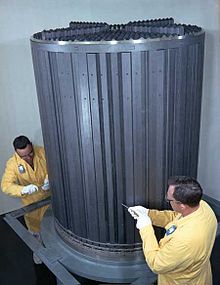- Nuclear graphite
-
Core graphite from the Molten-Salt Reactor Experiment

Nuclear graphite is any grade of graphite, usually electro-graphite, specifically manufactured for use as a moderator or reflector within nuclear reactors. Graphite is an important material for the construction of both historical and modern nuclear reactors as it is one of the purest materials manufactured at industrial scale and it retains its properties (including strength) at high temperatures.
Contents
History
In 1942 Enrico Fermi decided to use graphite as a moderator in the first attempt to create a self sustaining nuclear chain reaction. The initial attempt was not successful as the graphite was not sufficiently pure. A second attempt was made with AGX graphite, manufactured by the National Carbon Company, which successfully went critical. The Pile constructed was called the Chicago Pile-1.
Similar work had been undertaken in the USSR leading to findings similar to those in the USA. In particular, the negative temperature coefficient of reactivity was found, which became a major argument in favour of Graphite moderated reactors[citation needed] (see Classification of Nuclear Reactors).
Unlike the promising results in the US and in the USSR, German investigators came to the conclusion that graphite could not be used with natural uranium to produce a nuclear chain reaction. The purest graphite available to them at that time was a product from the Siemens Plania company, which exhibited a neutron absorption cross section of about 7.5 mb. Compared to that the graphites used in CP-1 exhibited average thermal absorption cross sections of 6.68 mb (AGX, National Carbon Company), 5.51 mb (Speer Carbon Company), and 4.97 mb (AGOT, National Carbon Company). (Haag [2005])
Already in December 1942, Eugene P. Wigner first called attention to the effects of fast particles on solids. It was suggested that neutrons from fission would displace atoms from their lattice sites by momentum transfer with effects on most of the properties of graphite, which has become known as the Wigner effect. The possibility was even suggested that graphite bars might fuse together as chemical bonds at the surface of the bars are opened and closed again, and during operation of a reactor enough energy would be deposited in the graphite to open all the chemical bonds several times. Even the possibility that the graphite parts might very quickly break into small pieces could not be ruled out. However, the first power-producing reactors (X-10 Graphite Reactor and Hanford B Reactor) had to be built without such knowledge. Cyclotrons, which were the only fast neutron sources available, would need several months of irradiation to produce damaging effects equivalent to one day in a Hanford reactor.
This was the starting point for large-scale research programmes to investigate the property changes due to fast particle radiation and to predict their influence on the safety and the lifetime of graphite reactors to be built. Influences of fast neutron radiation on strength, electrical and thermal conductivity, thermal expansitivity, dimensional stability, on the storage of internal energy (Wigner energy) and on many other properties have been observed many times and in many countries after the first results emerged from the X-10 reactor in 1944.
Although catastrophic behaviour such as fusion or crumbling of graphite pieces, has never occurred, large changes in many properties do result from fast neutron irradiation which need to be taken into account when graphite components of nuclear reactors are designed. Although not all effects are well understood yet, more than 100 graphite reactors have successfully operated in the last 60 years. A few severe accidents in graphite reactors can in no case be attributed to a lack of knowledge or insufficient properties of the graphite in use.
Purity
Care must be taken that reactor-grade graphite is free of neutron absorbing materials such as boron, widely used as the seed electrode in commercial graphite deposition systems-- this caused the failure of the Germans' World War II graphite-based nuclear reactors.
Behaviour under irradiation
This describes the behavior of nuclear graphite, specifically when exposed to fast neutron irradiation.
Specific phenomena addressed:
- Dimensional change (shrinkage and neutron induced swelling)
- Change in elastic modulus (measured by Impulse excitation technique)
- Change in coefficient of thermal expansion
- Change in thermal conductivity
- Change in electrical resistivity
- Irradiation induced creep
Manufacture
Nuclear graphite for the UK Magnox reactors were manufactured from petroleum coke mixed with coal-based binder pitch heated and extruded into bricks, and then baked at 1,000 °C for several days. To reduce porosity and increase density the bricks were impregnated with coal tar at high temperature and pressure before a final bake at 2,800 °C. Individual bricks were then machined into the final required shapes.[1]
Accidents in graphite-moderated reactors
There have been two major accidents in graphite moderated reactors, the Windscale fire and the Chernobyl disaster.
In the Windscale fire, however, the uranium fuel rather than the graphite in the reactor caught fire. The only graphite moderator damage was found to be localized around burning fuel elements.[2][3]
References
- Haag, G. 2005, Properties of ATR-2E Graphite and Property Changes due to Fast Neutron Irradiation, FZ-Juelich, Juel-4813.
- ^ Gareth B. Neighbour (2007). Management of ageing in graphite reactor cores. Royal Society of Chemistry. ISBN 9780854043453. http://books.google.co.uk/books?id=SdVvX2AlxmoC. Retrieved 2009-06-15.
- ^ "Meeting of RG2 with Windscale Pile 1 Decommissioning Project Team" (PDF). Nuclear Safety Advisory Committee. 2005-09-29. NuSAC(2005)P 18. http://www.hse.gov.uk/aboutus/meetings/iacs/nusac/131005/p18.pdf. Retrieved 2008-11-26.
- ^ Marsden, B.J.; Preston, S.D.; Wickham, A.J. (8–10 September 1997). "Evaluation of graphite safety issues for the British production piles at Windscale"]. AEA Technology (IAEA). IAEA-TECDOC—1043. http://www.iaea.org/inis/aws/htgr/abstracts/abst_29059916.html. Retrieved 13 November 2010.
Categories:- Neutron moderators
- Carbon forms
- Nuclear technology
Wikimedia Foundation. 2010.

